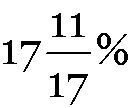Profit & Loss Worksheet-3
-
A bag marked at Rs. 80 is sold for Rs. 68. The rate of discount is:
(a) 12% (b) 15% (c)  (d) 20%
(d) 20%
-
A pair of articles was bought for Rs. 37.40 at a discount of 15%. What must be the marked price of each of the articles?
(a) Rs. 11 (b) Rs. 22 (c) Rs. 33 (d) Rs. 44
-
A shopkeeper gives 12% additional discount on the discounted price, after giving an initial discount of 20% on the labelled price of a radio. If the final sale price of the radio is Rs. 704, then what is its labelled price?
(a) Rs. 844.80 (b) Rs. 929.28 (c) Rs. 1000 (d) Rs. 1044.80
-
A fan is listed at Rs. 1500 and a discount of 20% is offered on the list price. What additional discount must be offered to the customer to bring the net price to Rs. 1104?
(a) 8% (b) 10% (c) 12% (d) 15%
-
A discount of 15% on one article is the same as a discount of 20% on another article. The costs of the two articles can be:
(a) Rs. 40, Rs. 20 (b) Rs. 60, Rs. 40
(c) Rs. 80, Rs. 60 (d) Rs. 60, Rs. 40
-
If the S.P. of Rs. 24 results in a 20% discount on list price, what S.P. would result in a 30% discount on list price?
(a) Rs. 18 (b) Rs. 20 (c) Rs. 21 (d) Rs. 27
-
An article was sold for Rs. y after giving a discount of x%. Then, its list price is:
(a)  (b)
(b)  (c)
(c)  (d) None of these
(d) None of these
-
Jatin bought a refrigerator with 20% discount on the labeled price. Had he bought it with 25% discount, he would have saved Rs. 500. What is the labeled price of the refrigerator?
(a) Rs. 5000 (b) Rs. 10,000 (c) Rs. 12,500 (d) Rs. 15,000
-
A manufacturer offers a 20% rebate on the marked price of a product. The retailer offers another 30% rebate on the reduced price. The two reductions are equivalent to a single reduction of:
(a) 40% (b) 44% (c) 46% (d) 50%
-
Successive discounts of 10%, 12% and 15% amount to a single discount of:
(a) 32.68% (b) 35.28% (c) 36.68% (d) None of these
-
List price of an article at a showroom is Rs. 2000 and it is being sold at successive discounts of 20% and 10%. Its net selling price will be:
(a) Rs. 1400 (b) Rs. 1440 (c) Rs. 1520 (d) Rs. 1700
-
Find the selling price of an article if a shopkeeper allows two successive discounts of 5% each on the marked price of Rs. 80.
(a) Rs. 70.10 (b) Rs. 70.20 (c) Rs. 72 (d) Rs. 72.20
-
The price of a VCR is marked at Rs. 12,000. If successive discounts of 15%, 10% and 5% be allowed, then at what price does a customer buy it?
(a) Rs. 8400 (b) Rs. 8721 (c) Rs. 8856 (d) None of these
-
After successive discounts of 12% and 5% an article was sold for Rs. 209. What was the original price of the article?
(a) Rs. 226 (b) Rs. 250 (c) Rs. 252 (d) Rs. 269
-
Applied to a bill for Rs. 1,00,000, the difference between a discount of 40% and two successive discounts of 36% and 4% is:
(a) Nil (b) Rs. 1440 (c) Rs. 2500 (d) Rs. 1960
Answer Key:
(1)-b; (2)-b; (3)-c; (4)-a; (5)-c; (6)-c; (7)-a; (8)-b; (9)-b; (10)-a; (11)-b; (12)-d; (13)-b; (14)-b; (15)-b
 (d) 20%
(d) 20% (b)
(b)  (c)
(c)  (d) None of these
(d) None of these